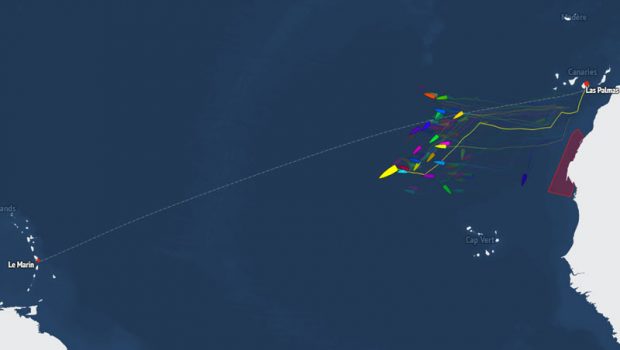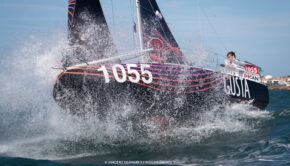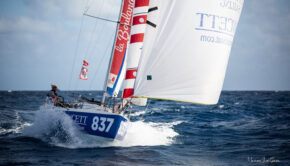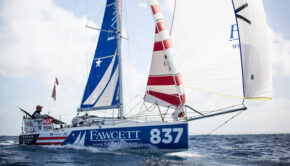Mini Transat: Southbound to pit row
Published on November 6th, 2019
(November 6, 2019; Leg 2; Day 5) – The conditions on the fleet of 82 Mini 6.50 solo sailors in the second leg of the Mini-Transat La Boulangère are taking their toll as Italians Matteo Sericano and Marco Buonanni have both broken a rudder and are making for Mindelo, in Cape Verde, where they’ll make a pit stop to effect repairs before, hopefully, returning to the racetrack.
The southerly trajectories by Sericano (888) and Buonanni (769) on the tracker suggested trouble which they soon confirmed through a message to Race Management. At 16:00 UTC, Matteo was about 200 miles from this port, and Marco around 350 miles away.
This evening, François Jambou (prototype) and Ambrogio Beccaria (production boat) are stretching out their respective leads.
Since the start in Las Palmas de Gran Canaria, three other competitors have made pit stops before setting sail again: Amélie Grassi, Marie Gendron, and Jean Lorre. The remaining 77 sailors crossing the Atlantic have surely had their share of hassles too, but have seemingly been able to deal with them offshore.
It’s interesting to note that a number of the mid-fleet sailors are taking on the long passage across the Atlantic in contact with fellow sailors. In this way, they’re able to chat over the VHF and doubtless dispense and receive reassurance.
Eight sailors are particularly bunched together on a N’ly course: Mathieu Gobet (455), Jean Bachèlerie (428), Thomas Gaschignard (539), Thomas D’Estais (819), Thibault Blanchet (774), Simon Tranvouez (807), Pierre Casenave-Péré (857), and Matthieu Perrault (825).
Further South is another group made up of Jean-René Guilloux (915), Thibault Raymakers (891), Olivier Le Fichous (721), Axelle Pillain (781), Albert Lagneaux (882), Christophe Brière (755), and Raphaël Lutard (900).
“This situation where sailors make headway as a group is a frequent occurrence mid-fleet in the Mini-Transat. However, the practice is less evident up front,” explains Denis Hugues, Race Director.
Prototypes:
François Jambou (865) is letting his prototype go into overdrive, constantly racking up high speeds as a result. His rivals have their work cut out trying to keep up with the hellish pace he’s setting. Indeed, it’s worth noting how second placed Tanguy Bouroullec (969) has slowed today. Does Tanguy have technical issues?
In any case, third placed Axel Tréhin is making the most of the opportunity to swoop in on his prey. After a complicated and backbreaking first leg due to energy woes, Antoine Perrin (850) is sailing a blinder in this leg and is lying in 5th position this evening, in contact with the experienced Erwan Le Méné (800).
Production boats:
The three competitors who secured a podium spot in the first leg are opting for very different courses in the second. Matthieu Vincent (947) is the furthest North of the fleet and Félix de Navacelle (916) is the furthest South. Between these two sailors, the lateral separation has stretched to 450 miles this evening!
As for the leader Ambrogio Beccaria (943), he’s gone for a passage through the middle where he’s really excelling himself. Astern, those who were favouring a S’ly course at the start of the race have re-positioned themselves behind him, as is the case for Florian Quenot and Nicolas D’Estais, who have been the fastest sailors in the production fleet over 24 hours, respectively posting distances of 291.47 and 290.03 miles over a day.
Ranking at 16:00 UTC:
PROTOTYPE
1. François Jambou (865 – Team BFR Marée Haute Jaune) 1,709.6 miles from the finish
2. Tanguy Bouroullec (969 – Cerfrance) 70.4 miles behind the leader
3. Axel Tréhin (945 – Project Rescue Ocean) 75.3 miles behind the leader
PRODUCTION
1. Ambrogio Beccaria (943 – Geomag) 1,724.8 miles from the finish
2. Benjamin Ferré (902 – Imago Incubateur D’aventures 28.0 miles behind the leader
3. Pierre Le Roy (925 – Arthur Loyd) 70.0 miles behind the leader
Event details – Entry list – Tracker – Facebook
The biennial Mini-Transat La Boulangère has competition for the Mini 6.50 Class in two divisions: the prototypes and the production boats.
Production boats are built out of fiberglass, have alloy masts, 1.6 meter draft, and prohibit material such as titanium, carbon fiber, and epoxy resin. Ten boats must have been built to qualify as an official production boat.
Prototypes, on their side, are free of these restrictions and have been, for years, the very first laboratory for sailing innovations. Canting keels, daggerboards, swinging wing masts, long poles for huge spinnakers, have been tried first on minis. New hull shapes with very wide waterlines and foils are the now the latest innovations.
Race Format:
Eighty-seven started the first leg on October 5 (delayed from September 22 due to storms) from La Rochelle, France and extends 1350 nm to Las Palmas de Gran Canaria. After an often complicated exit of the Bay of Biscay, sailors will expect some long slips down the Portuguese coast before arriving after 7 to 10 days in the Canary archipelago.
Eighty-two started the second leg on November 2 from Las Palmas de Gran Canaria and will take from 15 to 20 sailing days to complete the 2700 nm course and reach Le Marin in Martinique, French West Indies. Due to the numerous islands, the restart from the Canary can be tricky before reaching the famous trade winds that offer a long downwind run.
Source: Effetsmer










 We’ll keep your information safe.
We’ll keep your information safe.